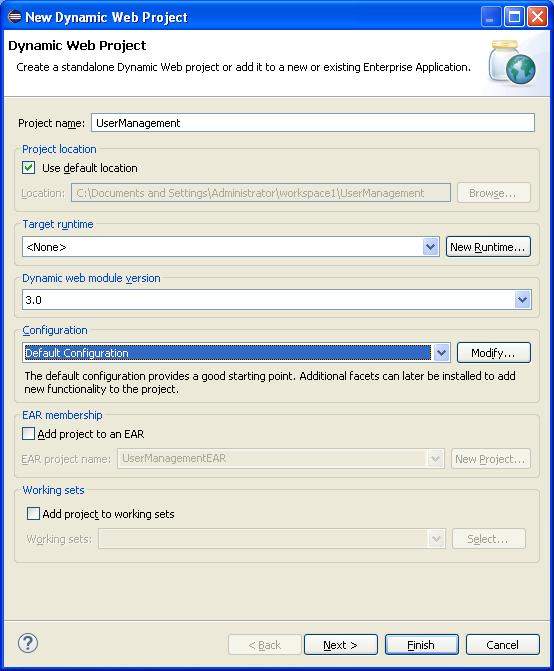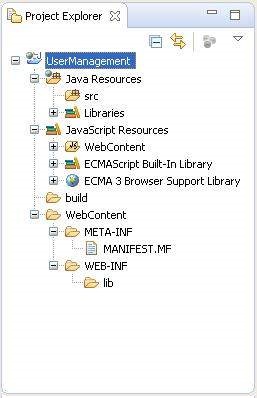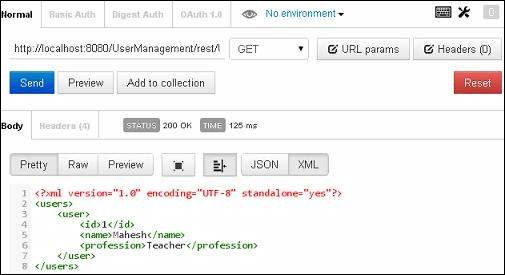RESTful Web Services
REST stands for REpresentational State Transfer.
REST is an architectural style not a protocol.
Advantages of RESTful Web Services
Fast: RESTful Web Services are fast because there is no strict specification like SOAP. It consumes less bandwidth and resource.
Language and Platform independent: RESTful web services can be written in any programming language and executed in any platform.
Can use SOAP: RESTful web services can use SOAP web services as the implementation.
Permits different data format: RESTful web service permits different data format such as Plain Text, HTML, XML and JSON.
What is REST architecture?
REST stands for REpresentational State Transfer. REST is web standards based architecture and uses HTTP Protocol. It revolves around resource where every component is a resource and a resource is accessed by a common interface using HTTP standard methods. REST was first introduced by Roy Fielding in 2000.
In REST architecture, a REST Server simply provides access to resources and REST client accesses and modifies the resources. Here each resource is identified by URIs/ global IDs. REST uses various representation to represent a resource like text, JSON, XML. JSON is the most popular one.
HTTP methods
Following four HTTP methods are commonly used in REST based architecture.
GET − Provides a read only access to a resource.
POST − Used to create a new resource.
DELETE − Used to remove a resource.
PUT − Used to update a existing resource or create a new resource.
HTTP also defines the following standard status code:
- 404: RESOURCE NOT FOUND
- 200: SUCCESS
- 201: CREATED
- 401: UNAUTHORIZED
- 500: SERVER ERROR
RESTful Service Constraints
- There must be a service producer and service consumer.
- The service is stateless.
- The service result must be cacheable.
- The interface is uniform and exposing resources.
- The service should assume a layered architecture.
Advantages of RESTful web services
- RESTful web services are platform-independent.
- It can be written in any programming language and can be executed on any platform.
- It provides different data format like JSON, text, HTML, and XML.
- It is fast in comparison to SOAP because there is no strict specification like SOAP.
- These are reusable.
- They are language neutral.
Introduction to RESTFul web services
A web service is a collection of open protocols and standards used for exchanging data between applications or systems. Software applications written in various programming languages and running on various platforms can use web services to exchange data over computer networks like the Internet in a manner similar to inter-process communication on a single computer. This interoperability (e.g., between Java and Python, or Windows and Linux applications) is due to the use of open standards.
Web services based on REST Architecture are known as RESTful web services. These webservices uses HTTP methods to implement the concept of REST architecture. A RESTful web service usually defines a URI, Uniform Resource Identifier a service, provides resource representation such as JSON and set of HTTP Methods.
Creating RESTFul Webservice
In next chapters, we'll create a webservice say user management with following functionalities −
| Sr.No. | URI | HTTP Method | POST body | Result |
|---|---|---|---|---|
| 1 | /UserService/users | GET | empty | Show list of all the users. |
| 2 | /UserService/addUser | POST | JSON String | Add details of new user. |
| 3 | /UserService/getUser/:id | GET | empty | Show details of a user. |
Let us start writing the actual RESTful web services with Jersey Framework. Before you start writing your first example using the Jersey Framework, you have to make sure that you have setup your Jersey environment properly as explained in the RESTful Web Services - Environment Setup chapter. Here, I am also assuming that you have a little working knowledge of Eclipse IDE.
So, let us proceed to write a simple Jersey Application which will expose a web service method to display the list of users.
Creating a Java Project
The first step is to create a Dynamic Web Project using Eclipse IDE. Follow the option File → New → Project and finally select the Dynamic Web Project wizard from the wizard list. Now name your project as UserManagement using the wizard window as shown in the following screenshot −

Once your project is created successfully, you will have the following content in your Project Explorer −

Adding the Required Libraries
As a second step let us add Jersey Framework and its dependencies (libraries) in our project. Copy all jars from following directories of download jersey zip folder in WEB-INF/lib directory of the project.
- \jaxrs-ri-2.17\jaxrs-ri\api
- \jaxrs-ri-2.17\jaxrs-ri\ext
- \jaxrs-ri-2.17\jaxrs-ri\lib
Now, right click on your project name UserManagement and then follow the option available in context menu − Build Path → Configure Build Path to display the Java Build Path window.
Now use Add JARs button available under Libraries tab to add the JARs present in WEBINF/lib directory.
Creating the Source Files
Now let us create the actual source files under the UserManagement project. First we need to create a package called com.javawindow. To do this, right click on src in package explorer section and follow the option − New → Package.
Next we will create UserService.java, User.java,UserDao.java files under the com.tutorialspoint package.
User.java
package com.javawindow; import java.io.Serializable; import javax.xml.bind.annotation.XmlElement; import javax.xml.bind.annotation.XmlRootElement; @XmlRootElement(name = "user") public class User implements Serializable { private static final long serialVersionUID = 1L; private int id; private String name; private String profession; public User(){} public User(int id, String name, String profession){ this.id = id; this.name = name; this.profession = profession; } public int getId() { return id; } @XmlElement public void setId(int id) { this.id = id; } public String getName() { return name; } @XmlElement public void setName(String name) { this.name = name; } public String getProfession() { return profession; } @XmlElement public void setProfession(String profession) { this.profession = profession; } }
UserDao.java
package com.javawindow; import java.io.File; import java.io.FileInputStream; import java.io.FileNotFoundException; import java.io.FileOutputStream; import java.io.IOException; import java.io.ObjectInputStream; import java.io.ObjectOutputStream; import java.util.ArrayList; import java.util.List; public class UserDao { public List<User> getAllUsers(){ List<User> userList = null; try { File file = new File("Users.dat"); if (!file.exists()) { User user = new User(1, "Mahesh", "Teacher"); userList = new ArrayList<User>(); userList.add(user); saveUserList(userList); } else{ FileInputStream fis = new FileInputStream(file); ObjectInputStream ois = new ObjectInputStream(fis); userList = (List<User>) ois.readObject(); ois.close(); } } catch (IOException e) { e.printStackTrace(); } catch (ClassNotFoundException e) { e.printStackTrace(); } return userList; } private void saveUserList(List<User> userList){ try { File file = new File("Users.dat"); FileOutputStream fos; fos = new FileOutputStream(file); ObjectOutputStream oos = new ObjectOutputStream(fos); oos.writeObject(userList); oos.close(); } catch (FileNotFoundException e) { e.printStackTrace(); } catch (IOException e) { e.printStackTrace(); } } }
UserService.java
package com.javawindow; import java.util.List; import javax.ws.rs.GET; import javax.ws.rs.Path; import javax.ws.rs.Produces; import javax.ws.rs.core.MediaType; @Path("/UserService") public class UserService { UserDao userDao = new UserDao(); @GET @Path("/users") @Produces(MediaType.APPLICATION_XML) public List<User> getUsers(){ return userDao.getAllUsers(); } }
There are two important points to be noted about the main program,
UserService.java
The first step is to specify a path for the web service using @Path annotation to the UserService.
The second step is to specify a path for the particular web service method using @Path annotation to method of UserService.
Creating the Web.xml configuration File
You need to create a Web xml Configuration file which is an XML file and is used to specify Jersey framework servlet for our application.
web.xml
<?xml version = "1.0" encoding = "UTF-8"?> <web-app xmlns:xsi = "http://www.w3.org/2001/XMLSchema-instance" xmlns = "http://java.sun.com/xml/ns/javaee" xsi:schemaLocation="http://java.sun.com/xml/ns/javaee http://java.sun.com/xml/ns/javaee/web-app_3_0.xsd" id = "WebApp_ID" version = "3.0"> <display-name>User Management</display-name> <servlet> <servlet-name>Jersey RESTful Application</servlet-name> <servlet-class>org.glassfish.jersey.servlet.ServletContainer</servlet-class> <init-param> <param-name>jersey.config.server.provider.packages</param-name> <param-value>com.javawindow</param-value> </init-param> </servlet> <servlet-mapping> <servlet-name>Jersey RESTful Application</servlet-name> <url-pattern>/rest/*</url-pattern> </servlet-mapping> </web-app>
Deploying the Program
Once you are done with creating source and web configuration files, you are ready for this step which is compiling and running your program. To do this, using Eclipse, export your application as a war file and deploy the same in tomcat.
To create a WAR file using eclipse, follow the option File → export → Web → War File and finally select project UserManagement and destination folder. To deploy a war file in Tomcat, place the UserManagement.war in the Tomcat Installation Directory → webapps directory and start the Tomcat.
Running the Program
We are using Postman, a Chrome extension, to test our webservices.
Make a request to UserManagement to get list of all the users. Put http://localhost:8080/UserManagement/rest/UserService/users in POSTMAN with GET request and see the following result.

Congratulations, you have created your first RESTful Application successfully.
No comments:
Post a Comment
Please share your feedback